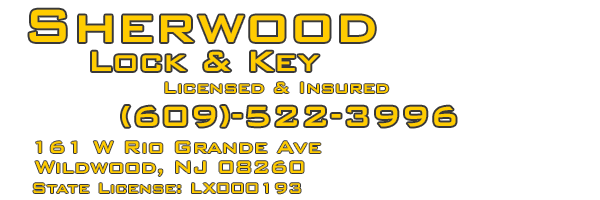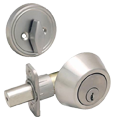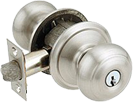

Also known as a "Skeleton Key" although that term has expanded to mean many different things as well. Rarely encountered today as they have been replaced by the much more popular and secure "Pin Tumbler" Lock.

Named because of the hollow end the key has (Barrel) that fits over a pin inside the lock. These are still found on many wood cabinets, drawers, and desks as they were originally used.

Commonly used today for safe deposit boxes. Sometimes on small metal drawer locks.

The most common key in use today. Many shapes, sizes, and forms. Used for virtually everything.

Commonly used for automotive keys today but also found on vending machines, cabinet locks, cartop carriers, and lock boxes. They come in many shapes and sizes but all characterized by cuts on the top and bottom edges of the key.

Common use vending machine locks, coin boxes, higher security padlocks, newer Harley Davidson ignitions, and commercial washing machine locks.

These are also commonly referred to as "Laser Cut" although there is no actual laser involved. They are found on many autos manufactured today and are also used for high security door locks. Extremely difficult to pick. Difficult to duplicate without specialized equipment. Cuts run along the flat side of the key rather than top and bottom edge. Best advice, don't lose these!

Medeco has designed a rather unique key/lock that incorporates angled key cuts, sidebar, and twisting pin tumbler locking mechanism. Extremely difficult to pick due to the dual locking and twisting tumblers. Mostly considered "pick-proof". These locks can be found on doors, ignition switches, vending machines, lock boxes, safes, virtually anywhere. Available in both restricted and non-restricted keyways. Requires special key machine to duplicate.

A passive electronic "chip" embedded in the head of the key that is computer coded to the ignition lock of a car. Used in conjunction with single sided, double sided, and sidewinder keys, both the cuts on the key and the programming must match for the car to start. Usually requires specialized equipment to program or sometimes can be programmed from the car itself. Some manufacturers require two working keys to program a third or more. Usually there is a finite amount of keys (8-11) that can be duplicated before a computer reset and reprogram is required.

There definitely are keys that are extremely difficult to get duplicated without authorization. There are restricted keyways to certain locations, buildings, locksmiths, and devices. Some will require special identification to be duplicated. However, stamping "Do Not Duplicate" on a standard keyblank is an extremely false sense of security. It can and will be copied. You can walk in anywhere and say 'I had that put on there so keys wouldn't be duplicated'. Who could know the difference? With the many "self service" key duplicating stations popping up everywhere there is a greater risk to security. If you want keys that can not be duplicated without permission you need to look in to actual restricted, electronic, bio-metric keys, or pushbutton locks.

Contrary to what you see on television and movies there is NO such thing as a "Master" key or small ring of "Super" keys that will open every door. It does not and cannot exist. That being said there are master keys that are part of a pre defined "Master System". This is set up within the lock itself (the only way to accomplish this) and has different sets of pins for the "change key" the one that a motel guest would get and the "master key" held by the motel owner/staff. It is specific to that building or group of locks it was designed for and will not work every other door in town. I should note that Police and Fire Departments have a "master key" of sorts. Usually referred to as a "Battering Ram". Will open most doors though!
There are many more varieties of keys mostly higher security types that are available. Magnetic, electronic, four sided, dimple, and some others.The above list are some of the more common types you can encounter on a day to day basis. With the advances in electronics, bio-metrics, and other means of personal identification the list will continue to grow. Chances are if you have one of these more advanced key systems you will be familiar with it. They don't usually come as a "surprise" when buying a lock or rekeying a building. Except when trying to get duplicates!

Any secondary lock opened by key from outside and knob on inside of door. Bolt, unlike spring latches used on knob locks, cannot be pushed back from lock postion. Much more secure than just a knob lock on door. Best used on doors without window inserts so inside knob is not accessable by breaking glass pane.

Secondary lock that must be opened or locked with a key from inside or outside of the door. Best security on doors with glass panels as they cannot be opened by hand through broken pane. Local fire codes may prevent installation of this type lock. Usually private residences may install them but not rental units. Unfortunate as it removes a layer of security in situation described above.

Everyone is familiar with this lock. It's used everywhere. The first line of defense against unauthorized entry. Available in several grades and configurations.

Similar in function to a knob lock but the lever allows much easier access for individuals that may have difficulty gripping and turning a knob. Their ease of use can also be the cause of abuse. Levers can be damaged by force that is easily applied to them. It's the nature of a "lever". Many higher end versions will have a clutch to minimize damage but it still has "leverage" advantage. Damage does not mean they will allow entry. But replacement may be only option to a forced lever lock.
Locks can and often times are installed upside down. This allows dirt and debris to collect in the working parts of the cylinder and can lead to failure. With very few exceptions door locks should be installed so that the cuts of the key face the top of the door. It is a simple matter to install them correctly and will prevent later problems. there are some storm door locks that are installed with cuts facing the floor. This is by design that seems to be mostly for the convenience of the manufacturer. It still allows debris to collect in the workings of the lock but since there is no way to reverse it there is no option. Lever locks will have the cuts facing the 3 or 9 o'clock position. Fortunately with lever locks it is not possible to install them upside down.